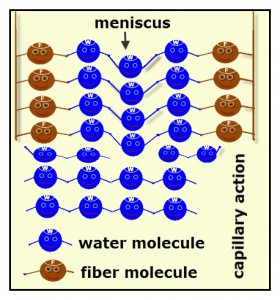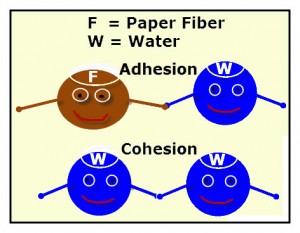How Does Water Move Through Paper?
Paper is made of plant fibers. In the process of making paper, the fibers overlap forming a massive network of tunnels in all directions throughout the paper. The chemical molecules making up the fibers are attractive to water water molecules. Adhesion is the name of the force of attraction between two unlike molecules.
FYI: I think of adhesive tape to remember this force. Adhesive tape is what I use to secure a bandage to skin. The tape molecules are attracted to skin molecules, thus the tape sticks.
Paper absorbs water because the paper molecules and water molecules attract, thus stick together.

Imagine an animated view of a paper fiber tunnel in a piece of paper. The water molecules and paper molecules are holding on to each other and helping each other move through the tunnel. Once the walls of the tunnel are covered the space between the walls would be empty (technically filled with air). But the water molecules have a strong attraction for each other. Cohesion is the force of attraction between like molecules.
The water molecules holding onto the fiber walls also hold onto water molecules forming a bridge of water molecules that spans the space between the wall. In other words, the fiber tunnel is filled with water. As the water molecules move up the fiber walls the water molecules spanning the space of the tunnel are pulled along. This is called capillary action.
Each of the 101 chemistry experiments has a purpose, list of materials, step-by-step instructions and illustrations, expected results, and a science explanation in understandable terms.
(paid link)

